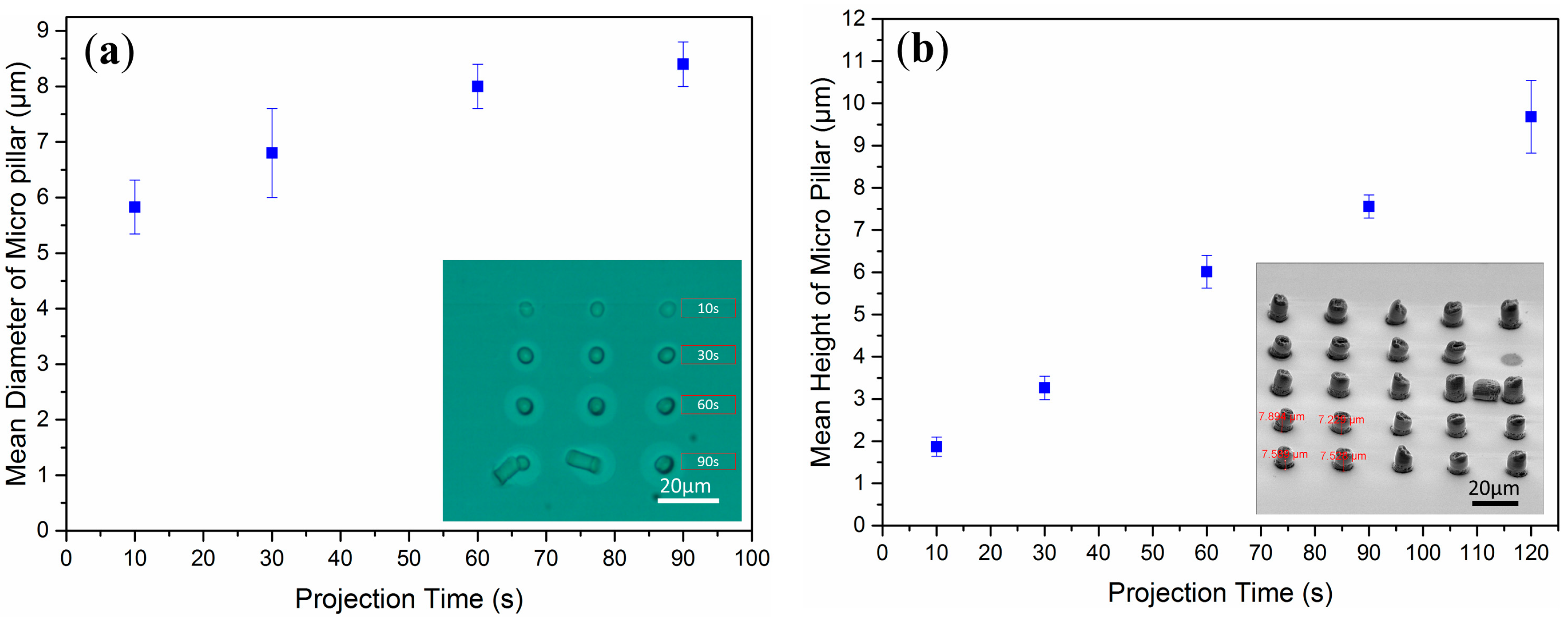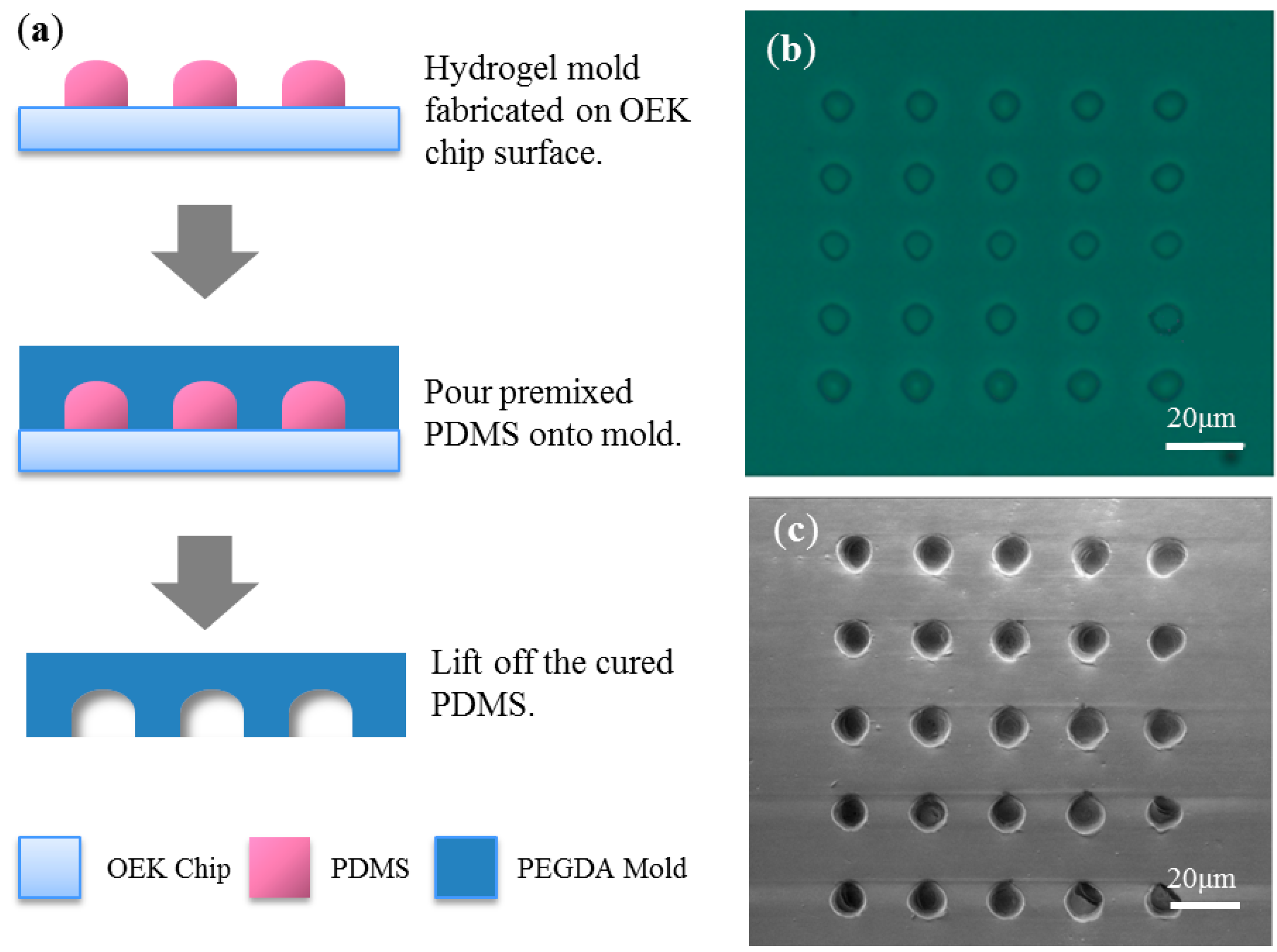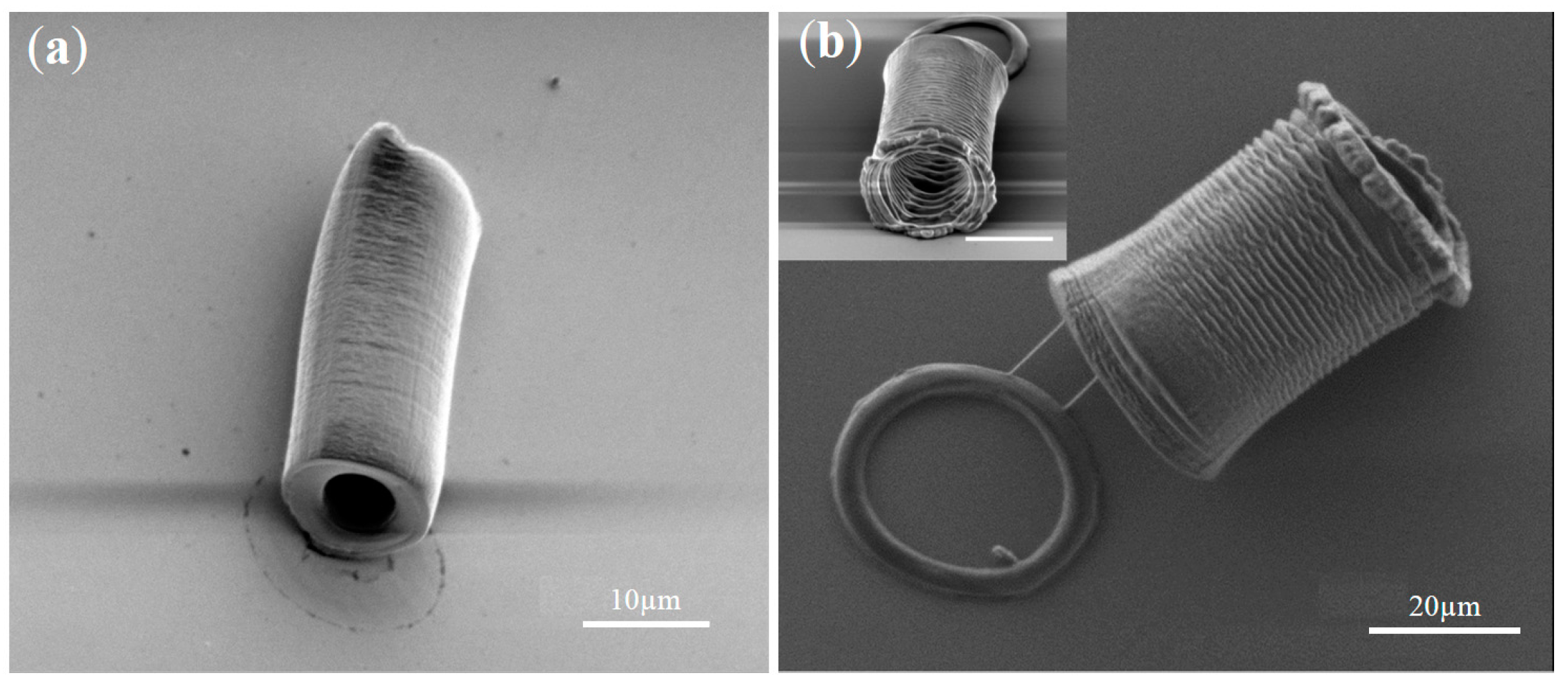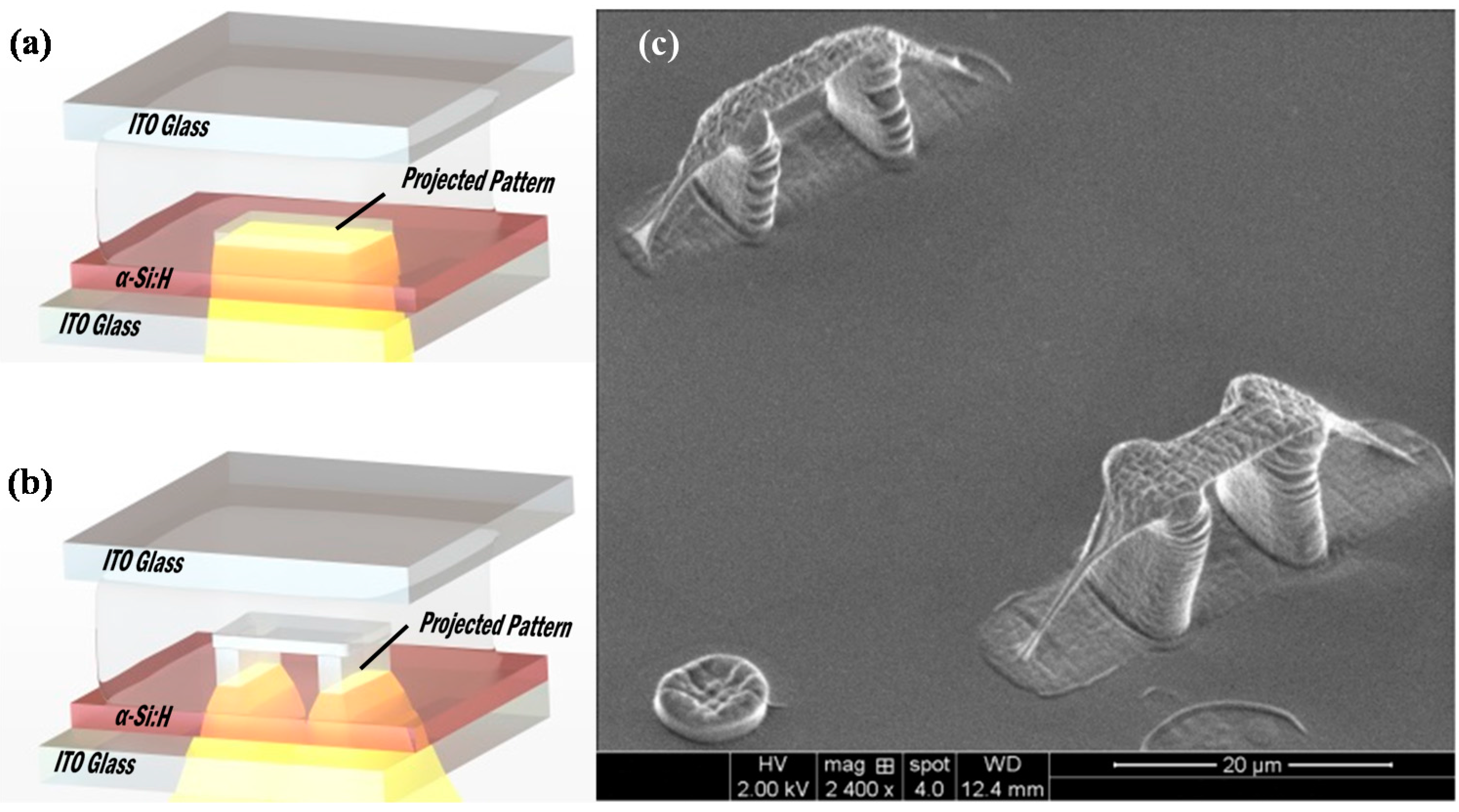Fabrication of High-Aspect-Ratio 3D Hydrogel Microstructures Using Optically Induced Electrokinetics
Abstract
:1. Introduction
2. Materials and Methods
2.1. OEK System
2.2. OEK-Induced Polymerization
2.3. Micro-Scale Feature Characterization
3. Results and Discussion
3.1. Effect of Solution Conductivity
3.2. Mold Fabrication
3.3. Micro-Scale Tube Fabrication
3.4. Polystyrene Bead Trapping by a Hydrogel Tube
3.5. 3D Undercut Features
4. Conclusions
Acknowledgments
Author Contributions
Conflicts of Interest
References
- Alting, L.; Kimura, F.; Hansen, H.N.; Bissacco, G. Micro Engineering. CIRP Ann. Manuf. Technol. 2003, 52, 635–657. [Google Scholar] [CrossRef]
- Ehmann, K.F.; Bourell, D.; Culpepper, M.L.; Hodgson, T.J.; Kurfess, T.R.; Madou, M.; Rajurkar, K. International Assessment of Research and Development in Micromanufacturing; World Technology Evaluation Center: Baltimore, MD, USA, 2005. [Google Scholar]
- Alfons, V.B.; Rene, R.; Pierre, W. Template-directed colloidal crystallization. Nature 1997, 385, 321–323. [Google Scholar]
- Wacaser, B.A.; Maughan, M.J.; Mowat, I.A.; Niederhauser, T.L.; Linford, M.R.; Davis, R.C. Chemomechanical surface patterning and functionalization of silicon surfaces using an atomic force microscope. Appl. Phys. Lett. 2003, 82, 808–810. [Google Scholar] [CrossRef]
- Wang, D.; Kodali, V.K.; Underwood, W.D., II; Jarvholm, J.E.; Okada, T.; Jones, S.C.; Okada, T.; Jones, S.C.; Rumi, M.; Dai, Z.; et al. Thermochemical nanolithography of multifunctional nanotemplates for assembling nano-objects. Adv. Funct. Mater. 2009, 19, 3696–3702. [Google Scholar] [CrossRef]
- Gerlier, L.; Lamotte, M.; Wille, M.; Kreuz, P.C.; Vanlauwe, J.; Dubois, D.; Meurgey, F.M. The cost utility of autologous chondrocytes implantation using ChondroCelect(R) in symptomatic knee cartilage lesions in Belgium. Pharm. Econ. 2010, 28, 1129–1146. [Google Scholar] [CrossRef] [PubMed]
- Lewis, J.A. Direct ink writing of 3D functional materials. Adv. Funct. Mater. 2006, 16, 2193–2204. [Google Scholar] [CrossRef]
- Hayward, R.C.; Saville, D.A.; Aksay, I.A. Electrophoretic assembly of colloidal crystals with optically tunable micropatterns. Nature 2000, 404, 56–59. [Google Scholar] [PubMed]
- Williams, S.J.; Aloke, K.; Steven, T.W. Electrokinetic patterning of colloidal particles with optical landscapes. Lab Chip 2008, 8, 1879–1882. [Google Scholar] [CrossRef] [PubMed]
- Chiou, P.Y.; Aaron, T.O.; Ming, C.W. Massively parallel manipulation of single cells and microparticles using optical images. Nature 2005, 436, 370–372. [Google Scholar] [CrossRef] [PubMed]
- Kumar, A.; Chuang, H.S.; Steven, T.W. Dynamic manipulation by light and electric fields: Micrometer particles to microliter droplets. Langmuir 2010, 26, 7656–7660. [Google Scholar] [CrossRef] [PubMed]
- Wang, S.; Liang, W.F.; Dong, Z.L.; Lee, G.B.; Li, W.J. Fabrication of micrometer- and nanometer-scale polymer structures by visible light induced dielectrophoresis (DEP) force. Micromachines 2010, 2, 431–442. [Google Scholar] [CrossRef]
- Dang, T.D.; Kim, Y.H.; Choi, J.H.; Kim, G.M. A novel simple preparation method of a hydrogel mold for pdms micro-fluidic device fabrication. J. Micromech. Microeng. 2012, 22, 15–17. [Google Scholar] [CrossRef]
- Liu, N.; Li, P.; Liu, L.; Yu, H.; Wang, Y.; Lee, G.B.; Li, W.J. 3-D non-UV digital printing of hydrogel microstructures by optically controlled digital electropolymerization. J. Microelectromech. Syst. 2015, 9, 2128–2135. [Google Scholar] [CrossRef]
- Levenberg, S.; Rouwkema, J.; Macdonald, M.; Garfein, E.S.; Kohane, D.S.; Darland, D.C.; Marini, R.; van Blitterswijk, C.A.; Mulligan, R.C.; D’Amore, P.A.; et al. Engineering vascularized skeletal muscle tissue. Nat. Biotech. 2005, 23, 879–884. [Google Scholar] [CrossRef] [PubMed]
- Griffith, L.G.; Swartz, M.A. Capturing complex 3D tissue physiology in vitro. Nat. Rev. Mol. Cell Biol. 2006, 7, 211–224. [Google Scholar] [CrossRef] [PubMed]
- Uludag, H.; De Vos, P.; Tresco, P.A. Technology of mammalian cell encapsulation. Adv. Drug Deliv. Rev. 2000, 42, 29–64. [Google Scholar] [CrossRef]
- Liu, N.; Liang, W.; Liu, L.; Wang, Y.; Mai, J.D.; Lee, G.B.; Li, W.J. Extracellular-controlled breast cancer cell formation and growth using non-UV patterned hydrogels via optically-induced electrokinetics. Lab Chip 2014, 14, 1367–1376. [Google Scholar] [CrossRef] [PubMed]







© 2016 by the authors. Licensee MDPI, Basel, Switzerland. This article is an open access article distributed under the terms and conditions of the Creative Commons by Attribution (CC-BY) license ( http://creativecommons.org/licenses/by/4.0/).
Share and Cite
Li, Y.; Lai, S.H.S.; Liu, N.; Zhang, G.; Liu, L.; Lee, G.-B.; Li, W.J. Fabrication of High-Aspect-Ratio 3D Hydrogel Microstructures Using Optically Induced Electrokinetics. Micromachines 2016, 7, 65. https://doi.org/10.3390/mi7040065
Li Y, Lai SHS, Liu N, Zhang G, Liu L, Lee G-B, Li WJ. Fabrication of High-Aspect-Ratio 3D Hydrogel Microstructures Using Optically Induced Electrokinetics. Micromachines. 2016; 7(4):65. https://doi.org/10.3390/mi7040065
Chicago/Turabian StyleLi, Yi, Sam H. S. Lai, Na Liu, Guanglie Zhang, Lianqing Liu, Gwo-Bin Lee, and Wen Jung Li. 2016. "Fabrication of High-Aspect-Ratio 3D Hydrogel Microstructures Using Optically Induced Electrokinetics" Micromachines 7, no. 4: 65. https://doi.org/10.3390/mi7040065




